Difference between revisions of "February 7, 2009"
| Line 1: | Line 1: | ||
__NOTOC__ | __NOTOC__ | ||
=An Ancient Ring?= | =An Ancient Ring?= | ||
| − | |||
<!-- ws:start:WikiTextHeadingRule:2:<h1> --> | <!-- ws:start:WikiTextHeadingRule:2:<h1> --> | ||
<!-- ws:start:WikiTextLocalImageRule:8:<img src="/file/view/LPOD-Feb7-09.jpg/56753378/LPOD-Feb7-09.jpg" alt="" title="" /> -->[[File:LPOD-Feb7-09.jpg|LPOD-Feb7-09.jpg]]<!-- ws:end:WikiTextLocalImageRule:8 --><br /> | <!-- ws:start:WikiTextLocalImageRule:8:<img src="/file/view/LPOD-Feb7-09.jpg/56753378/LPOD-Feb7-09.jpg" alt="" title="" /> -->[[File:LPOD-Feb7-09.jpg|LPOD-Feb7-09.jpg]]<!-- ws:end:WikiTextLocalImageRule:8 --><br /> | ||
| − | <em>image by [mailto:kcpaulhk@yahoo.com.hk K.C. Pau], Hong Kong</em><br /> | + | <em>image by [mailto:kcpaulhk@yahoo.com.hk" rel="nofollow K.C. Pau], Hong Kong</em><br /> |
<br /> | <br /> | ||
| − | The face of the Moon that we see is merely the last of many faces that the Moon has exposed to Earth over the last 4.5 billion years. We can [http://www.donaldedavis.com/PARTS/SHORTBIO.html imagine] what the Moon looked like before the most recent craters formed, but its harder to imagine all the craters that previously existed but are now gone. Sometimes there are hints of what might have been. For example, is the curved mare ridge in the center all that is left of a large crater? Based on the curve it would have been about a 200 km wide crater, nearly as big as another slightly younger crater [http://lpod.wikispaces.com/October+10%2C+2008 Deslandres]. There really should be craters on top of craters on top of craters.<br /> | + | The face of the Moon that we see is merely the last of many faces that the Moon has exposed to Earth over the last 4.5 billion years. We can [http://www.donaldedavis.com/PARTS/SHORTBIO.html" rel="nofollow imagine] what the Moon looked like before the most recent craters formed, but its harder to imagine all the craters that previously existed but are now gone. Sometimes there are hints of what might have been. For example, is the curved mare ridge in the center all that is left of a large crater? Based on the curve it would have been about a 200 km wide crater, nearly as big as another slightly younger crater [http://lpod.wikispaces.com/October+10%2C+2008 Deslandres]. There really should be craters on top of craters on top of craters.<br /> |
<br /> | <br /> | ||
| − | <em>[mailto:tychocrater@yahoo.com Chuck Wood]</em><br /> | + | <em>[mailto:tychocrater@yahoo.com" rel="nofollow Chuck Wood]</em><br /> |
<br /> | <br /> | ||
<strong>Technical Details</strong><br /> | <strong>Technical Details</strong><br /> | ||
Revision as of 19:04, 4 January 2015
An Ancient Ring?

image by " rel="nofollow K.C. Pau, Hong Kong
The face of the Moon that we see is merely the last of many faces that the Moon has exposed to Earth over the last 4.5 billion years. We can " rel="nofollow imagine what the Moon looked like before the most recent craters formed, but its harder to imagine all the craters that previously existed but are now gone. Sometimes there are hints of what might have been. For example, is the curved mare ridge in the center all that is left of a large crater? Based on the curve it would have been about a 200 km wide crater, nearly as big as another slightly younger crater Deslandres. There really should be craters on top of craters on top of craters.
" rel="nofollow Chuck Wood
Technical Details
February 4, 2009; 12:34 UT
Related Links
Rükl plate 42



